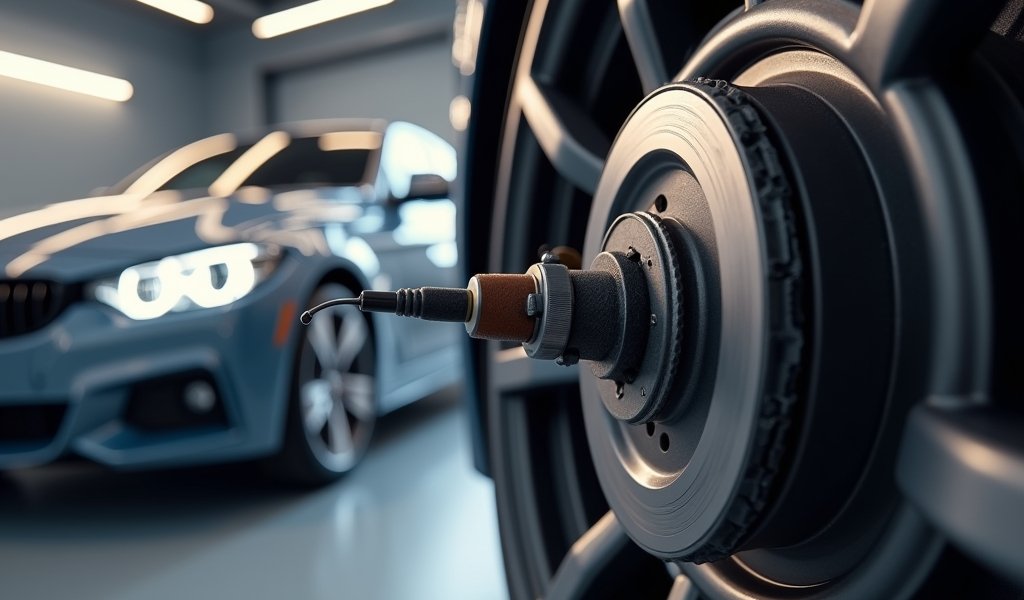Overview
This article provides a detailed guide on maintaining ABS wheel speed sensors, explaining their crucial role in vehicle safety and offering step-by-step cleaning instructions to prevent system failures. Regular cleaning of these sensors prevents false ABS activations, extends component life, and ensures optimal braking performance during emergency situations, with clear indicators for when replacement is necessary instead of cleaning.
Table of Contents
- Understanding ABS Wheel Speed Sensors
- Why Cleaning ABS Sensors Matters
- Signs Your ABS Wheel Speed Sensors Need Cleaning
- Tools Needed for Proper Cleaning
- Step-by-Step Cleaning Process
- Preventative Maintenance Tips
- Common Mistakes to Avoid
- When Cleaning Isn’t Enough: Replacement Guide
- Conclusion
- Frequently Asked Questions
Understanding ABS Wheel Speed Sensors
ABS wheel speed sensors are the unsung heroes of your vehicle’s safety system, silently monitoring each wheel’s rotation speed to prevent lock-ups during braking. I’ve spent two decades getting intimate with these little magnetic wonders, and trust me when I say they deserve more attention than they typically receive. These sensors create a magnetic field that interacts with a toothed ring (also called a tone ring), generating electrical pulses as the wheel rotates.
Think of them as tiny speed-reading guardians positioned at each wheel. When you slam on the brakes, your ABS control module relies on these sensors to determine if any wheel is rotating slower than the others – a telltale sign of impending lock-up. Without clean, properly functioning sensors, your ABS can’t do its job, potentially compromising your safety in emergency braking situations.
Most vehicles feature either passive sensors (older models) or active sensors (newer vehicles). Passive sensors generate their own voltage while active ones require external power. Regardless of type, both are equally susceptible to contamination that can impair their functionality. A properly maintained sensor ensures your vehicle maintains stability and control during those heart-stopping moments when every millisecond of reaction time matters.
Why Cleaning ABS Sensors Matters
I can’t count how many times I’ve seen drivers drop hundreds on unnecessary sensor replacements when a simple cleaning would have solved their problem. ABS wheel speed sensor cleaning isn’t just about saving money—though that’s certainly a welcome bonus. It’s about maintaining one of your vehicle’s critical safety systems at optimal performance.
These sensors live in one of your car’s most hostile environments. Positioned close to the road, they endure constant bombardment from debris, road salt, mud, and metallic particles shed from your brakes. Over time, this buildup creates a barrier between the sensor and the tone ring, interfering with the magnetic field they use to communicate. The result? Erratic readings, false ABS activations, or complete system failure when you need it most.
Regular cleaning also gives you the opportunity to inspect for damage before a minor issue becomes a major headache. I’ve rescued countless sensors caught in the early stages of failure—saving my customers significant repair costs. Plus, proper winter car maintenance including sensor cleaning can extend the life of these components substantially, especially in regions where road salt accelerates corrosion.

Signs Your ABS Wheel Speed Sensors Need Cleaning
Your car is surprisingly communicative about sensor issues if you know what to listen for. The most obvious sign is an illuminated ABS light on your dashboard. This warning shouldn’t be ignored, but it doesn’t necessarily mean you need new sensors. In many cases, a thorough cleaning resolves the issue.
Have you noticed your ABS engaging during normal braking, especially at lower speeds? That pulsing sensation in the brake pedal when you’re barely slowing down often points to sensor contamination. The system is receiving incorrect speed data and thinks you’re skidding when you’re not. Similarly, traction control acting up on dry pavement can indicate the same problem, as both systems rely on these sensors.
Some subtler signs include unexplained speedometer fluctuations or cruise control that disengages randomly. These happen because your vehicle’s computer is receiving inconsistent wheel speed readings. If you’ve experienced any of these symptoms, especially after driving through rainy seasons or on dirt roads, your sensors likely need attention.
During routine maintenance, I always check for visible contamination around the sensors. A buildup of dark, gritty material is a sure indicator that cleaning is needed, even if warning lights haven’t appeared yet. As automotive safety experts recommend, preventative maintenance of ABS components significantly reduces the risk of system failure.
Tools Needed for Proper Cleaning
Before diving into ABS wheel speed sensor cleaning, gathering the right tools makes all the difference between a successful job and potential frustration. You don’t need fancy equipment, but specificity matters here. I’ve refined my toolkit over years of practice to include just what’s necessary.
For accessing the sensors, you’ll need:
- Jack and jack stands (safety first—never work under a vehicle supported only by a jack)
- Wheel chocks to prevent rolling
- Socket set and wrench set (metric or standard depending on your vehicle)
- Torque wrench for proper reassembly
- Flathead and Phillips screwdrivers
For the actual cleaning process, gather:
- Brake cleaner spray (non-residue formula)
- Electronic parts cleaner (for the electrical connections)
- Soft bristle brush (an old toothbrush works perfectly)
- Lint-free microfiber cloths
- Compressed air can or compressor with blowgun attachment
- Small plastic scraper for stubborn debris (never use metal tools on sensors)
- Anti-seize compound (for sensor mounting bolts)
Optional but helpful tools include a small inspection mirror, a headlamp for better visibility, and dielectric grease for protecting electrical connections. I also recommend having a factory service manual or reliable online resource specific to your vehicle model, as sensor locations and removal procedures vary significantly between makes and models.
Remember, quality matters with cleaning agents. Avoid household cleaners or general degreasers that might leave residue or damage the sensitive components. The few extra dollars spent on proper automotive cleaners will save headaches down the road.
Step-by-Step Cleaning Process
Now for the main event—cleaning those sensors properly. I’ve refined this process through countless service appointments, finding the sweet spot between thoroughness and efficiency. Safety comes first: ensure your vehicle is securely supported on jack stands and the wheels are properly chocked before beginning.
First, locate your ABS sensors. They’re typically mounted in the wheel hub or knuckle assembly, with a wire leading away from them. Most vehicles have one per wheel, though positioning varies by make and model. Consult your service manual if you’re having trouble finding them. Before removing anything, take a moment to inspect the wiring harness connected to the sensor for damage or corrosion.
Next, carefully disconnect the electrical connector by pressing the release tab and gently pulling apart. Never yank on the wires. Some sensors are held in place by a single bolt, while others may use clips or multiple fasteners. Remove these carefully, noting their positions for reassembly. Extract the sensor by pulling straight out—avoid twisting or bending motions that could damage it.
With the sensor removed, examine it closely. The sensing tip (usually a magnetic end) is where most contamination occurs. Using your soft brush and electronic parts cleaner, gently clean this surface. For stubborn debris, soak briefly in cleaner, then brush again. The goal is to remove all foreign material without scratching the sensor face.
While the sensor is out, inspect the mounting hole and tone ring (the toothed ring it reads) for damage or excessive rust. Clean the tone ring with brake cleaner and your brush, removing any debris between the teeth. This step is crucial yet often overlooked—a clean sensor won’t help if the ring it’s reading is contaminated.
After thorough cleaning, dry everything completely with compressed air and lint-free cloths. Before reinstallation, apply a thin layer of anti-seize compound to the mounting bolt (not the sensor itself) to prevent future corrosion issues that could make removal difficult. Reinstall the sensor, ensuring it seats fully and squarely in its mounting hole.
Reconnect the electrical connector, making sure it clicks securely into place. Some mechanics recommend applying a small amount of dielectric grease to the connector to prevent future corrosion, but check your vehicle specifications first as some connectors are specifically designed to remain grease-free.
Finally, lower the vehicle, start the engine, and check that the ABS light extinguishes after the initial system check. Take a test drive to ensure everything is functioning properly. As NHTSA brake safety guidelines emphasize, properly functioning ABS systems are essential for maintaining vehicle control during emergency braking.

Preventative Maintenance Tips
An ounce of prevention is worth a pound of cure, especially when it comes to ABS wheel speed sensor cleaning. I’ve seen firsthand how regular preventative care can extend sensor life significantly. The frequency of cleaning depends largely on your driving conditions—those facing harsh winters with road salt or regular off-road adventures will need more frequent attention than highway commuters in dry climates.
Start by incorporating sensor inspection into your seasonal maintenance routine. I recommend checking them at least twice yearly, ideally before winter and again in spring. This timing aligns perfectly with preparing your car for road salt season and addressing any damage afterward.
When washing your vehicle, pay special attention to wheel wells and undercarriage areas. A strong spray directed at these areas can dislodge accumulating debris before it causes issues. For those living in coastal regions or areas with heavy road salt usage, consider monthly undercarriage washes during winter to minimize corrosion risk.
Apply a thin coat of dielectric grease to sensor connectors (but never the sensor face itself) during routine maintenance to prevent moisture intrusion. This simple step creates a waterproof barrier that can prevent connection issues down the road. Similarly, a light application of anti-seize compound on mounting bolts during scheduled service makes future removal much easier.
Consider installing mud flaps if your vehicle doesn’t have them. They significantly reduce the amount of road grime reaching your sensors, especially on trucks and SUVs. Additionally, promptly addressing any ABS warning lights rather than hoping they’ll go away can prevent more extensive damage to the system.
Common Mistakes to Avoid
Through years of fixing others’ DIY attempts, I’ve cataloged the most common pitfalls in ABS wheel speed sensor cleaning. Avoiding these mistakes will save you time, money, and potential safety issues. The most frequent error I see is using excessive force during sensor removal. These components are typically made of plastic and can break easily if pried or twisted improperly.
Another critical mistake is cleaning sensors with the wrong products. Harsh solvents, WD-40, or household cleaners can damage the delicate components or leave residue that interferes with operation. Stick to automotive electronic cleaners designed specifically for sensitive components. Similarly, using metal tools like screwdrivers or wire brushes to scrape debris can permanently scratch the sensor face, rendering it useless.
Many DIYers overlook cleaning the tone ring while focusing solely on the sensor. Both components must be clean for proper operation—it’s a two-way relationship. Also, failure to properly dry components before reassembly can trap moisture against metal parts, accelerating corrosion.
When reinstalling, avoid overtightening mounting bolts. These should be torqued to manufacturer specifications—too tight and you risk damaging threads or breaking the sensor housing; too loose and you get inaccurate readings or sensor movement. Finally, neglecting to clear fault codes after cleaning is a common oversight. Even after proper cleaning, your ABS light may remain illuminated until codes are cleared with a scanner.
When Cleaning Isn’t Enough: Replacement Guide
Sometimes, despite your best efforts at ABS wheel speed sensor cleaning, replacement becomes necessary. Knowing when to make this call saves time and prevents frustration. If your sensor shows physical damage—cracks in the housing, bent mounting tabs, or a damaged sensing tip—cleaning won’t resolve the issue. Similarly, if the wiring harness shows bare wires, melted insulation, or connector damage, replacement is your only option.
Performance issues that persist after thorough cleaning point to internal sensor failure. If your ABS light returns immediately after clearing codes, or you continue experiencing erratic ABS engagement despite clean components, the sensor’s internal circuitry may be compromised. Age is another consideration—most sensors have a lifespan of 80,000 to 100,000 miles, though this varies by manufacturer and driving conditions.
When replacement becomes necessary, always opt for OEM or high-quality aftermarket parts. This is one area where saving a few dollars on bargain parts often leads to premature failure and repeated labor. Before purchasing, confirm compatibility with your specific vehicle year, make, and model, as sensors can look similar but have different electrical characteristics.
Installation of new sensors follows the same procedure as reinstallation after cleaning, with one additional step: many new sensors come with protective covers on the sensing tip that must be removed before installation. Always follow manufacturer torque specifications for mounting bolts and perform a thorough test drive after replacement to ensure proper system function.
According to federal vehicle safety experts, maintaining proper ABS function should be considered a priority safety issue rather than an optional repair. The marginal cost of timely sensor replacement is insignificant compared to the potential consequences of ABS failure during an emergency braking situation.
Conclusion
Mastering ABS wheel speed sensor cleaning is one of those maintenance skills that delivers benefits far beyond the modest time investment required. Throughout my years turning wrenches, I’ve seen countless drivers avoid expensive repairs simply by implementing regular sensor maintenance into their vehicle care routine.
Remember that these unassuming components play a critical role in your vehicle’s safety systems. Clean sensors ensure your ABS functions precisely as designed, potentially making the difference between a near-miss and an accident when road conditions turn challenging. The process isn’t complicated, but attention to detail matters tremendously.
By following the steps outlined here—proper tool selection, careful removal, thorough cleaning of both sensors and tone rings, and correct reinstallation—you’re not just saving money on unnecessary parts replacement. You’re actively maintaining one of your vehicle’s most important safety systems.
Whether you’re preparing for winter driving challenges, addressing an illuminated ABS light, or simply being proactive about maintenance, regular sensor cleaning delivers peace of mind that’s well worth the effort. Your braking system will respond more predictably, your warning lights will stay dark, and you’ll extend the lifespan of components that are increasingly sophisticated and expensive to replace.
Take it from someone who’s seen the consequences of neglect—this is preventative maintenance that truly matters. Your future self will thank you when your ABS performs flawlessly during that unexpected emergency stop.
Frequently Asked Questions
How often should I clean my ABS wheel speed sensors?
For most drivers, cleaning every 12-18 months is sufficient. However, increase to every 6 months if you frequently drive on unpaved roads or in areas with heavy road salt usage.
Can I clean ABS sensors without removing them?
It’s possible to perform basic cleaning with compressed air and brake cleaner without removal. For thorough maintenance, however, removal provides much better access and cleaning results.
Will cleaning my ABS sensors turn off the ABS light?
Often yes, but you may need to clear the stored fault codes with a scanner after cleaning. The system sometimes needs this reset to recognize the problem has been resolved.
What’s the average cost to replace an ABS sensor professionally?
Professional replacement typically costs between $150-$350 per sensor, including parts and labor. Costs vary significantly depending on vehicle make and sensor accessibility.
Can dirty ABS sensors affect my vehicle’s fuel efficiency?
Indirectly, yes. Malfunctioning sensors can cause the computer to enter a “limp mode” that alters engine performance and transmission shift patterns, potentially reducing fuel economy.

